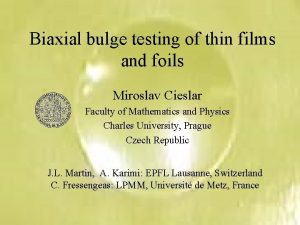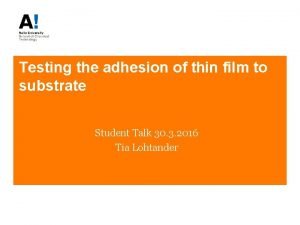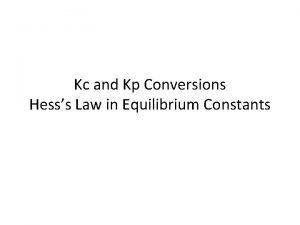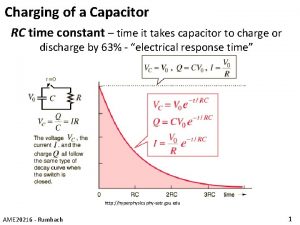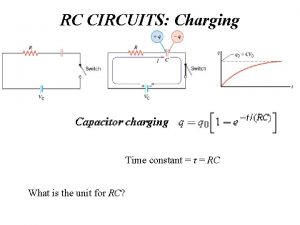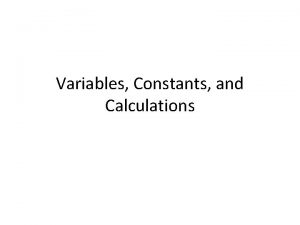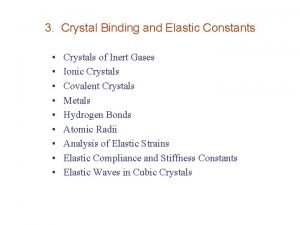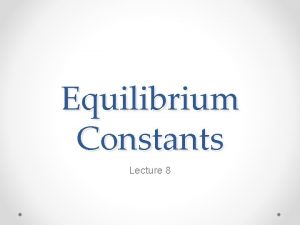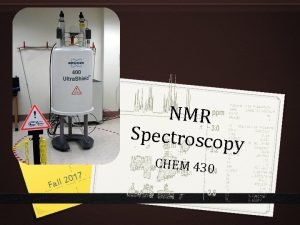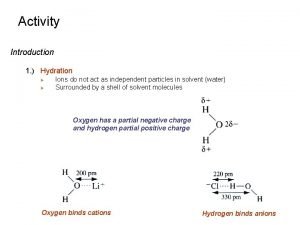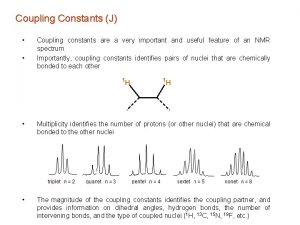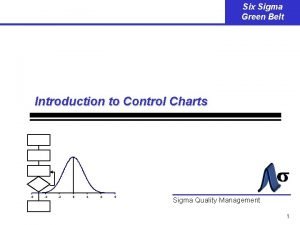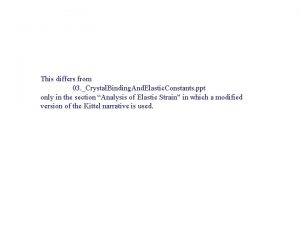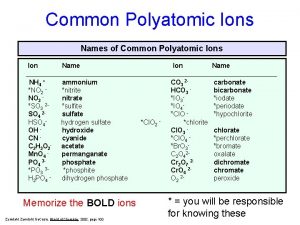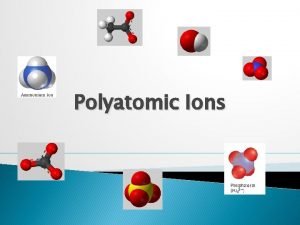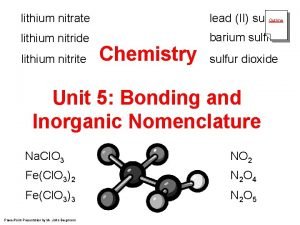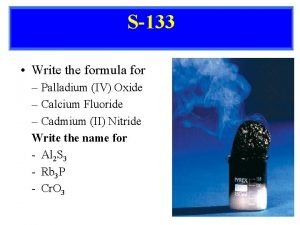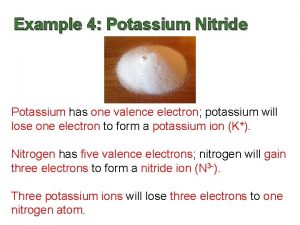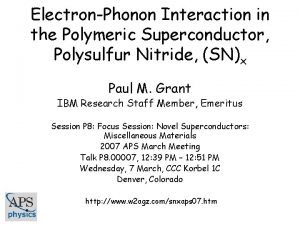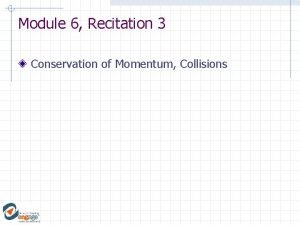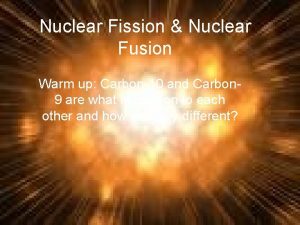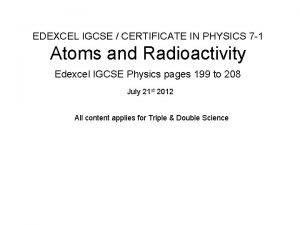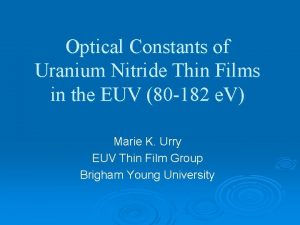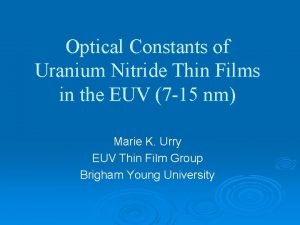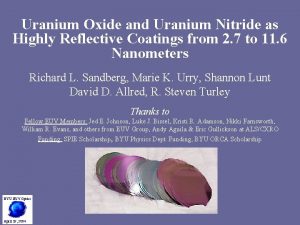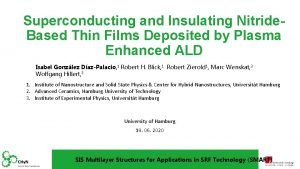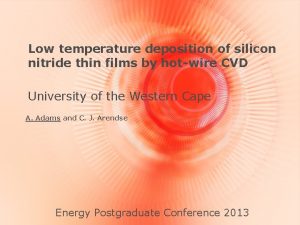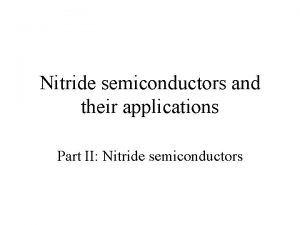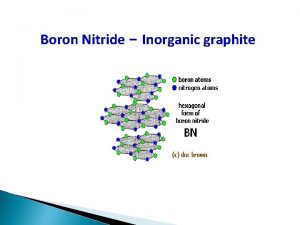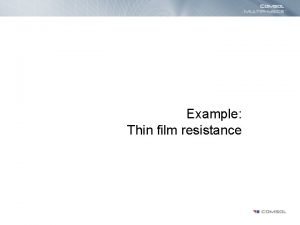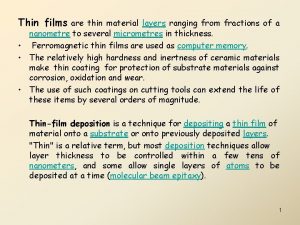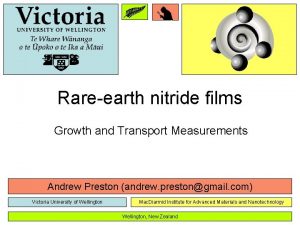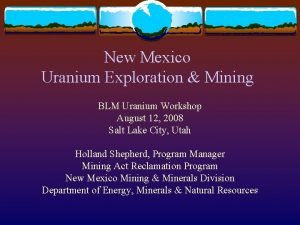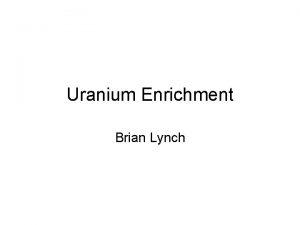Optical Constants of Uranium Nitride Thin Films in








































- Slides: 40

Optical Constants of Uranium Nitride Thin Films in the EUV (80 -182 e. V) Marie K. Urry EUV Thin Film Group Brigham Young University

Acknowledgements Thanks to: Dr. David D. Allred Dr. R. Steven Turley Kristi R. Adamson Luke J. Bissell Jennie Guzman Elke Jackson Winston Larsen Mindy Tonks Department Funding

Outline Ø Why We Do What We Do Ø Making Thin Films Ø Studying Thin Films Ø Finding Optical Constants l Reflectometer

Why Extreme Ultraviolet (EUV)? Ø Astronomy l Ø Lithography l l Ø Our IMAGE Satellite Mirror Projection Imagining Scheduled for 2009 Medicine l High Resolution Imaging Microscopes Images courtesy of http: //euv. lpl. arizona. edu/euv/, www. schott. com/magazine/english/info 99/ and www. schott. com/magazine/english/info 99/.

Optical Constants Ø Index of refraction: N = n + i k Ø In EUV, n ≈ 1 and k is huge. → n = 1 - k = Ø High and low for maximum reflection for multilayers.

Delta-Beta Scatter Plot at 220 e. V β

Why Uranium Nitride? Ø Uranium l High theoretical reflectivity due to high Ø Problem: Oxidation Ø Nitride l l Little effect on reflectivity Prevents oxidation

Reflectance computed using the CXRO Website: http: //www-cxro. lbl. gov/optical_constants/mirror 2. html

Reflectance computed using the CXRO Website: http: //www-cxro. lbl. gov/optical_constants/mirror 2. html

Delta-Beta Scatter Plot at 220 e. V β

Making Thin Films Ø Sputtering l l Bombard target, uranium, with argon ions Uranium atoms leave target due to collisions Nitrogen partial pressure in plasma introduces N atoms U and UN molecules deposit on our samples

Making Thin Films Ø 10 -30 nm thick Ø Deposited on: l l l silicon wafers quartz slides polyimide films Si. N membranes carbon coated TEM grids Ø Low pressure sputtering l smooth, dense, low stress films

Side Note for Clarification Ø Samples 002 – 005 l l 002 and 003 are U 2 N 3 004 and 005 are UN • 005 is new and unmeasured

Making Thin Films Ø Partial pressure determines stoichiometry Ø Our system couldn’t control partial pressures in the critical range N 2 Partial Pressure vs N/U Ratio Image courtesy of L. Black, et al. , Journal of Alloys and Compounds, 315 (2001) 36 -41.

Learning About the Samples Ø Composition l Depends on partial pressure in system Ø Thickness l Crystal monitor is to the side of the film and gets less accurate with time Ø Roughness Ø Optical Constants

X-Ray Photoelectron Spectroscopy (XPS) Ø Uses photoelectric effect to find composition Images courtesy of http: //volta. byu. edu/adamson 03. pdf.

X-Ray Photoelectron Spectroscopy (XPS) Counts Survey Scan of Surface Identifying Peaks: 100 e. V – U 5 d 5/2 280 e. V – C 1 s 380 e. V – U 4 f 7/2 390 e. V – U 4 f 5/2 398 e. V – N 1 s 530 e. V – O 1 s 740 e. V – U 4 d 5/2 780 e. V – U 4 d 3/2 980 e. V – Auger O Energy (e. V)

X-Ray Photoelectron Spectroscopy (XPS) Uranium Energy Peaks Counts Energy (e. V)

X-Ray Photoelectron Spectroscopy (XPS) Nitrogen Energy Peaks Counts Energy (e. V)

X-Ray Diffraction (XRD) To find thickness Ø m λ = 2 d = 2 sin θ sin Ø

XRD Data Change in theta between 8 peaks minima around theta=1. 5 for UO 2

XRD Data

Atomic Force Microscopy (AFM) Ø To Measure Roughness Ø Result: RMS roughness Images courtesy of http: //www. weizmann. ac. il/surflab/peter/afmworks/.

Length Scale vs. RMS Y= -0. 5666 x +1. 677

Transmission Electron Microscope (TEM)

Transmission Electron Microscope (TEM)

SAMPLES N 2 Pressure Suspected Phase UN 002 UN 003 UN 004 >1 e-4 torr ~1 e-5 torr U 2 N 3 UN Lattice Size Literature (Å) XRD (Å) 5. 34 5. 0 4. 89 4. 0 TEM (Å) Ratio (measured/lit) 5. 46 1. 022 4. 98 1. 018

Ellipsometry Ø Optical constants are different for different polarizations of light Ø If we know the substance and a model for the optical constants, we can find thickness and optical constants in UV Images courtesy of http: //www. swt. edu/~wg 06/manuals/Gaertner 117/ellipsometer. Home. htm.

Finding Optical Constants Ø Advanced Light Source at Berkeley l l Light created by synchrotron Measures reflectance at different angles and wavelengths Image courtesy of http: //www. lbl. gov/.

Reflectometer Ø Reassembled and aligned

Hollow Cathode Light Source Plasma with H or He Ø 700 V DC Ø Spectral Lines from He Ø l 304 Angstroms • 2 p->1 s l 584 Angstroms • 1 s 2 p->1 s 2 Found leaks Ø Replace plexi-glass Ø

Reflectometer Replaced CEM Ø Purchased stages and stepper motors Ø Electron Multiplier Tube

Reflectometer Ø Lab VIEW Program for Centering Detector l l Assumed a Gaussian Theta/2*theta misalignment

Reflectometer Ø Other Improvements l l Ø Circuit diagrams SOP’s Still working l Fixing virus problems

On to Berkeley!


Outline Ø Background (9 minutes) l l l Ø Why EUV? Optical Constants Why Uranium? Making & Studying Thin Films (13 minutes) l l l Ø Sputtering XPS XRD AFM TEM Ellipsometry Finding Optical Constants (10 minutes) l l l What we want to know ALS Reflectometer/ Monochromator Results/Continuing Research (8 minutes) Ø Acknowledgements (1 minute) Ø

To Do Ø Learn about light source (internet) Ø Ellipsometry stuff (Dr. Allred) Ø Update “Problem!!” and data slides (Dr. Allred)

IMD Ø Written by David Wendt Ø Computes reflectivities of materials based on their optical constants Ø We used UO model because of similar densities Ø (Insert graph here)

Problem!! Ø Our samples change with time. l The peaks seen in XRD move. Ø Continuing research in this area.
 Working titles films
Working titles films Bulge test thin films
Bulge test thin films Thin films testing
Thin films testing Steady state error control system
Steady state error control system Hess law for equilibrium constants
Hess law for equilibrium constants Is time constant
Is time constant Rc time constant
Rc time constant Factors affecting chemical shift in nmr spectroscopy
Factors affecting chemical shift in nmr spectroscopy Marc overmars game maker
Marc overmars game maker Scientific method constant
Scientific method constant Chem
Chem Constants c#
Constants c# Units of gas constant
Units of gas constant Crystals for binding
Crystals for binding Equiibrium constant
Equiibrium constant Geminal coupling
Geminal coupling Equilibrium constants
Equilibrium constants Avogadro's law constant
Avogadro's law constant What is
What is Constant maths definition
Constant maths definition Constants in scientific method
Constants in scientific method Hyperfine splitting
Hyperfine splitting Walter shewhart
Walter shewhart Crystal binding and elastic constants
Crystal binding and elastic constants Named constants in java
Named constants in java Matlab constants
Matlab constants Elastic deformation vs plastic deformation
Elastic deformation vs plastic deformation Ni3 lewis dot structure
Ni3 lewis dot structure Co42- ion name
Co42- ion name Ionic compounds are neutral true or false
Ionic compounds are neutral true or false Kiocompound name
Kiocompound name Polyatomic cation example
Polyatomic cation example Lead(ii)nitride
Lead(ii)nitride Palladium(iv) fluoride formula
Palladium(iv) fluoride formula Oxidation number of potassium
Oxidation number of potassium Potassium has one valence electron
Potassium has one valence electron Polysulfur nitride
Polysulfur nitride Uranium atomic mass
Uranium atomic mass A uranium nucleus at rest undergoes fission
A uranium nucleus at rest undergoes fission Who discovered uranium
Who discovered uranium Uranium 238 alpha decay equation
Uranium 238 alpha decay equation

